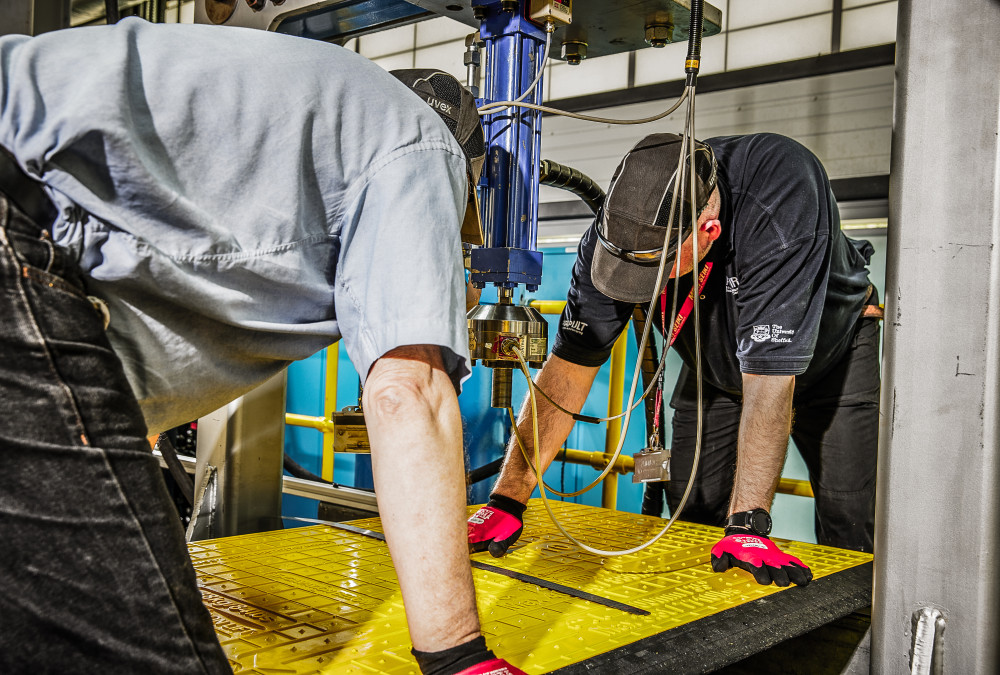Construction site hazards

How to stay safe on a construction site
The construction industry provides a workplace environment that presents high risks and hazards to workers; often requiring the use of heavy tools, large machinery and plant, as well as coming into contact with hazardous materials. It is important to be able to identify hazards on a construction site – and understand how to avoid them. Learn more about how to stay safe on a construction site from our detailed guide.
Top building site hazards to be aware of
Working at height
Working at height is one of the most common construction site hazards. In 2015/16, The Health and Safety Executive (HSE) found that over a quarter of fatalities at work were from falling from height. Working at height must be properly supervised, planned and should be avoided, where possible. Equipment with extra safety measures, such as double guard rails for scaffolding, should be used to reduce risk of fatalities, and safety nets can be used to minimise the consequences of a fall.
- Noise
You don’t need to work on a construction site to be familiar with the high noise levels that come from this sort of work. However, noise is a common construction hazard – as loud and repetitive noises can cause long-term hearing problems. Therefore, the right ear protective equipment must be used. Loud noises from building work can also create distractions, which can lead to accidents. Employers are required to carry out a comprehensive noise risk assessment, which will lead to issuing the correct PPE for the job. - Moving objects
As building sites are ever-changing environments, they can quickly become hectic workplaces when objects are continually moving. This could include overhead lifting equipment, diggers and supply vehicles. Workers should avoid working closely to these objects if possible, while being constantly vigilant of their surroundings and wearing PPE where necessary – for example, a high visibility jacket to ensure they are seen more easily. - Instability
Slips, trips and falls are common construction site hazards. This is due to the instability of the environment construction workers are subjected to – for example, uneven terrain and incomplete buildings. Stairwells and footpaths should be used in order to avoid falls as well as providing designated walkways, such as temporary zebra crossings, for construction workers to travel around the site safely. Obstacles, such as excess material and cables, should be removed to avoid instability – and wet or slippery surfaces should be treated with grit and properly sign posted. - HAVS
Hand Arm Vibration Syndrome (HAVS), also known as ‘blue finger’, is a disease which debilitates the blood vessels, joints and nerves. This is usually caused by the prolonged and consistent use of hand power tools, which provide a vibration through the hand and arm. HAVS can be prevented by wearing the appropriate protection equipment when using vibrating tools, and the equipment itself being regularly assessed and maintained. - Electricity
Naturally with a construction site, there will likely be electricity running through various circuits, especially through electrical live parts, which is something workers need to be aware of. This can be a hazard if you touch the live parts directly or come into contact with overhead or underground power cables, which can cause electric shocks. This can then lead to falls from ladders, scaffolds or other work platforms, which can in turn lead to fatalities. - Asbestos
Asbestos is a natural fibrous rock that can often be found hidden in public buildings that construction workers will have to come into contact with. This harmful material initially acts as an insulator, keeping heat in or the cold out, but is one of the biggest occupational disease risks to construction workers. It can lead to mesothelioma – a cancer of the lung lining – and asbestos-related lung cancer; both of which are almost always fatal. Employers must undertake a risk assessment of the site to ensure there is no asbestos, or, if there is, that this is identified and recorded, and anyone carrying out work in the area is notified. - Respiratory diseases
With building sites comes the risk of airborne fibres and materials, which can cause damage to your lungs, and cause respiratory problems. As the dust on construction sites is often not easy to spot with the naked eye, it’s hard to know that it contains a toxic mixture of hazardous materials, which can lead to diseases such as chronic obstructive pulmonary disease, silicosis or asthma. Employers not only need to issue PPE, but they must ensure that this PPE is used by their workers. - Unintended collapse
Excavations and trenches can collapse unintentionally on construction sites at any time, which can lead to workers being buried or seriously injured. This is especially common with building demolitions or buildings under construction. Precautions must be taken before construction work starts on these buildings, including considering what support is best suited for the trench ensuring the trench is secure; and regular inspections of any excavations to be completed before and after the work shift.
Now we’ve covered the top building site hazards to be aware of, and how to stay safe on a construction site, familiarise yourself with our construction site safety solutions to ensure you are as safe as you can be on site. From Avalon safety barriers to highwayman cones, Oxford Plastics’ wide selection has you covered. Get in touch with a member of our expert team for more information on avoiding construction hazards.
Related News

What happens on a product training day?
Here at Oxford Plastics our knowledgeable team is on hand to provide comprehensive training so that you can be confident in c...

Oxford Plastics Innovation for HAUC Compliant Products
Here at Oxford Plastics, our products are manufactured to the highest possible standards so that they not only comply with HA...

Health and Safety Calendar 2024
Safety has been at the core of innovation at Oxford Plastics for the last 35 years, and as we enter 2024, we’ve compile...